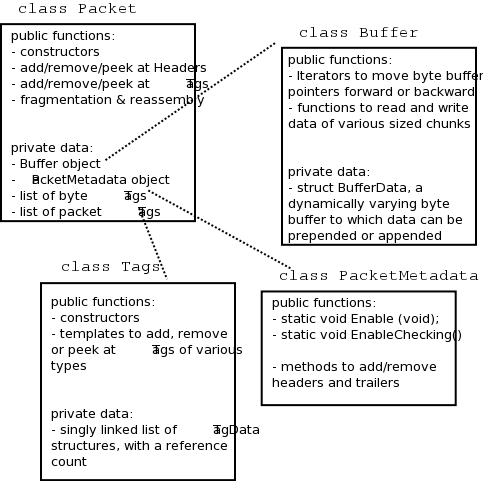
| [ < ] | [ > ] | [ << ] | [ Up ] | [ >> ] | [Top] | [Contents] | [Index] | [ ? ] |
Unlike ns-2, in which Packet objects contain a buffer of C++ structures corresponding to protocol headers, each network packet in ns-3 contains a byte Buffer, a list of byte Tags, a list of packet Tags, and a PacketMetadata object:
Figure 11.1: Implementation overview of Packet class.
Figure fig:packets is a high-level overview of the Packet implementation; more detail on the byte Buffer implementation is provided later in Figure fig:buffer. In \nsthree, the Packet byte buffer is analogous to a Linux skbuff or BSD mbuf; it is a serialized representation of the actual data in the packet. The tag lists are containers for extra items useful for simulation convenience; if a Packet is converted to an emulated packet and put over an actual network, the tags are stripped off and the byte buffer is copied directly into a real packet.
Packets are reference counted objects. They are handled with smart pointer (Ptr) objects like many of the objects in the ns-3 system. One small difference you will see is that class Packet does not inherit from class Object or class RefCountBase, and implements the Ref() and Unref() methods directly. This was designed to avoid the overhead of a vtable in class Packet.
The Packet class is designed to be copied cheaply; the overall design is based on Copy on Write (COW). When there are multiple references to a packet object, and there is an operation on one of them, only so-called "dirty" operations will trigger a deep copy of the packet:
ns3::Packet::AddHeader()
ns3::Packet::AddTrailer()
both versions of ns3::Packet::AddAtEnd()
Packet::RemovePacketTag()
The fundamental classes for adding to and removing from the byte
buffer are class Header and class Trailer.
Headers are more common but the below discussion also largely applies to
protocols using trailers. Every protocol header that needs to
be inserted and removed from a Packet instance should derive from
the abstract Header base class and implement the private pure
virtual methods listed below:
ns3::Header::SerializeTo()
ns3::Header::DeserializeFrom()
ns3::Header::GetSerializedSize()
ns3::Header::PrintTo()
Basically, the first three functions are used to serialize and deserialize
protocol control information to/from a Buffer. For example,
one may define class TCPHeader : public Header. The
TCPHeader object will typically consist of some private data
(like a sequence number) and public interface access functions
(such as checking the bounds of an input). But the underlying
representation of the TCPHeader in a Packet Buffer is 20 serialized
bytes (plus TCP options). The TCPHeader::SerializeTo() function would
therefore be designed to write these 20 bytes properly into
the packet, in network byte order. The last function is used
to define how the Header object prints itself onto an output stream.
Similarly, user-defined Tags can be appended to the packet. Unlike Headers, Tags are not serialized into a contiguous buffer but are stored in lists. Tags can be flexibly defined to be any type, but there can only be one instance of any particular object type in the Tags buffer at any time.
| [ < ] | [ > ] | [ << ] | [ Up ] | [ >> ] |
This document was generated by root on May 3, 2010 using texi2html 1.82.